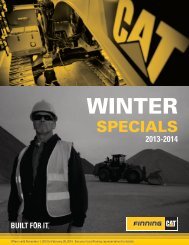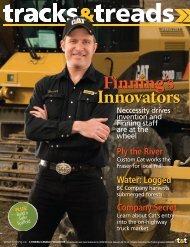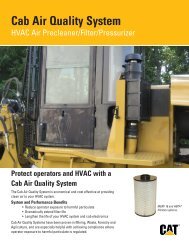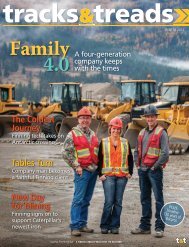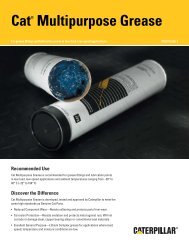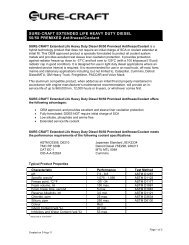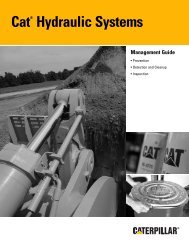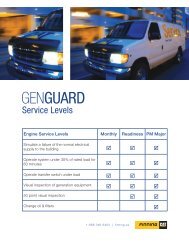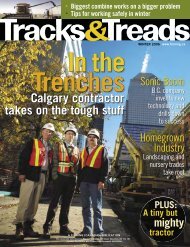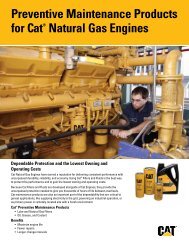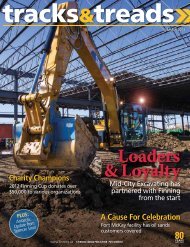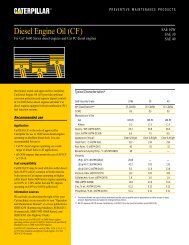Special Report - Finning Canada
Special Report - Finning Canada
Special Report - Finning Canada
You also want an ePaper? Increase the reach of your titles
YUMPU automatically turns print PDFs into web optimized ePapers that Google loves.
SUMMER 2009Why is thisman smiling?See page 18.MAXIMIZE UPTIME<strong>Special</strong> <strong>Report</strong><strong>Finning</strong> boasts new and revampedservices to keep you up and runningTake CommandExpose your machine's secret lifePlacid LakeOne B.C. family business facesthe downturn with serenityPower PointsPlanned maintenance readiesbackup generatorsDO IT!Protect YourPower Trainwww.finning.caA FINNING (CANADA) PUBLICATION Non-deliverable mail should be directed to: 10259 105 Street, Edmonton, AB T5J 1E3 Canadian Publications Mail Product Agreement #40020055
UnrivalledProduct SupportWe’ve expanded our service infrastructure to ensure you receivethe best service in the business. With our investment in the Centreof Excellence facility, located centrally in Red Deer, Alberta, we haveoptimized our new equipment preparation process, resulting inimproved shop capacity at all 50 service branch locations throughoutB.C., Alberta, Yukon and Northwest Territories. This increased shopcapacity means reduced downtime and quicker turn-around fromshop to fi eld.At <strong>Finning</strong>, we have the people, experience and capacity tomake sure your equipment is in top condition, ready to supportyour business.Contact your local <strong>Finning</strong> representative for more details.1-888-finning | finning.ca(346-6464)
How Do You Like Us Now?We decided to shake things upa little with a fresh, new look;tell us what you thinkby Jen Janzenassociate editorWelcome to the new improved Tracks & Treads!We’ve done some tweaking to our story lineup andgiven our appearance a bit of a facelift, stopping justshort of infusing the magazine with natural goodnessfrom the rainforest. Our stories are snappier andspeak directly to you and your business. The result?In our opinion, a fresher, livelier information sourcefor iron enthusiasts. What do you think? Let me knowat jjanzen@finning.ca. This issue also represents myfirst contributions to T&T – it’s nice to meet you. Inthis issue, our theme focuses on uptime: how owneroperatorsare getting more of it and what you can do toincrease your own share of it.In some ways, uptime boils down to a simpleconcept: preventive maintenance. Proper lubricants,filtration, oil sampling and overall condition monitoringcan make the difference between uptime and downtime.If you perform diligent maintenance, you shouldbe rewarded with more hours of use. Think of it asscheduled downtime that increases your overall uptime.Another bonus is that by performing regular preventivemaintenance, you catch problems before they becomecatastrophic, especially when your efforts are supportedby <strong>Finning</strong>’s various product support programs. Andcatching trouble right before it rears its head meansyou decrease the risk of pulling your machine off dutytoo early.<strong>Finning</strong> (<strong>Canada</strong>)’s product support marketingmanager Stu McLeod agrees that finding the optimalrepair before failure date can be difficult.“It’s the Holy Grail of all maintenance programs,” hesaid, “and the fulfillment of a machine owner’s ultimategoal of maximizing component life.”But hitting this elusive target does not meanscheduling repair before it’s necessary. Every owneroperatorwants to keep a machine performing at itstop capacity, but replacing components before they’veexpired – when you could have gotten many morehours of use out of them – ends up costing yourbusiness more money.Ultimately, Stu says, a machine is eventually goingto need repair whether it’s had a strict preventivemaintenance regimen or not. But preventivemaintenance, along with a healthy dose of advice from<strong>Finning</strong>’s seasoned product support pros, will extendthe life of your machine, maximizing your uptime byhelping you make sure you aren’t shutting it down toolate – or too early.tracks & treadsSummer 2009www.finning.ca
sUMMER 2009 Volume 49, No. 2PublisherRuth Kellyrkelly@venturepublishing.caassociate PublisherDaska DavisExecutive EditorJeff Howardjhoward@finning.caAssociate editorJen Janzenjjanzen@finning.caEditorMifi PurviscoPY CHIEFKim TannasEditorial AdvisorsDanna Beatty, Michelle Loewen, Patrick Kingart directorCharles Burkecburke@venturepublishing.caassistant ART DIRECTORRodrigo López OrozcoProduction COORDINATORBetty-Lou Smithcirculation coordinatorAndrea Cruickshankcirculation@venturepublishing.caAdvertising representativeAnita McGillisamcgillis@venturepublishing.caContributing WritersRobin Brunet, David DiCenzo, Katherine Fawcett,Keith Haddock, Noémi LoPinto, Lindsey Norris,Rick Overwater, Lisa Ricciotti, Jesse Semko, Jim StirlingContributing PHOTOGRAPHERS and illustratorsJody Crawford, Scott Dutton, Ricardo Alberto Leiva,Darren Nisbet, Heff O’Reilley, Kelly Redinger, Chip ZdarskyTracks & Treads is published to provide its readerswith relevant business, technology, productand service information in a livelyand engaging manner.NOT FINNISH YET: It was with keen interest that I found the picture andcaption “Log Day Afternoon” in the fall 2008 issue of Tracks & Treads.In my younger years, I often heard the name “Tomsum EE-Larky.” Both mygrandfathers, Olaf and Hugo, were Finnish and both had worked forThomsen and Clark. Like many new immigrants to <strong>Canada</strong>, they struggledwith English.Both grandfathers have long since passed away. I remember someof their logging stories and I know they worked for more than one outfit.I asked my father if Olaf and Hugo had talked much about Thomsen andClark to him. Dad could not shed any new light on the situation, but hecalled up a family friend who could, Leonard Tournquist. His father (alsoFinnish) worked for Thomsen and Clark. Leonard thinks Thomsen andClark had been logging near Harrison Lake. He also said there was a bookcalled Harrison Lake Challenge that might have information aboutThomsen and Clark. I’d appreciate if you could forward to me anyinformation that you might find on Thomsen and Clark.Doug Vitick, Mildred Lake, AlbertaDETECTIVE: I am writing to let you know that I am familiar with the surroundingsin the photo on page 42 of the fall 2008 issue. It was taken atan area near Hunt Creek, on Vancouver Island, on a Thompson Clark spurline off of the Horne Lake line. There were two of these machines:Caterpillar tractor and hoister arch. This was approximately 1935. I verymuch enjoy my T&T subscription.D.S. McMillanTHUMBS UP: I used to live in Edmonton and work for <strong>Finning</strong>. I have beenretired for eight years now. When I write that, I wonder where the time hasgone. Have just finished thumbing through the latest issue ofT&T spring ’09 and had to write andcongratulate you and the rest of the T&Tstaff on what has become a high-qualitypublication. I read every issue and havebeen meaning to write for some time.The last few years, with the introductionof “Bill’s Business,” has really seen themagazine shine. Good job.Dave Floyd, Vancouver, B.C.Tracks & Treads is published for<strong>Finning</strong> (<strong>Canada</strong>) byVenture Publishing Inc.10259-105 StreetEdmonton, Alberta T5J 1E3Phone: 780-990-0839Fax: 780-425-4921Contents © 2009 by <strong>Finning</strong> (<strong>Canada</strong>)No part of this publication should bereproduced without written permission.Tell us what you thinkTracks & Treads would love to hear from you. Tell us what you thinkof the magazine’s stories, columns and look, so that we can improveit and make it a more interesting read.Send your comments to executive editor Jeff Howard by email atjhoward@finning.ca or the old-fashioned way to: Jeff Howard, Tracks & Treads,<strong>Finning</strong> (<strong>Canada</strong>), 16830 – 107 Avenue, Edmonton, Alberta T5P 4C3www.finning.cawww.finning.catracks & treadsSummer 200932
y david dicenzo, Jeff Howard and Jen Janzen“Get me eight engines, stat!”The US Army Corps of Engineers helps keep shipping channels open on theWest Coast of the USA by operating two hopper dredges. The larger of those twodredges, the Portland-based Essayons, recently had eight state-of-the-art Catmarine engines installed which, in dredge parlance, is a heart transplant for themonster vessel.“The new engines have greatly improved our operational efficiency,” said CaptainJames Holcroft, in charge of the Essayons for six years.“With the old engines, when dredging upstream andgoing against a strong current, we barely had enoughpower to maintain forward motion. With the newCaterpillar engines, we have an extra 2,000 hp enablingus to get the job done, even under difficult conditions.”EssayonsBy the NumbersThe length of theEssayons, in metres.106.74The number of CatC280-12 main enginesused in the Essayons‘“heart transplant.”0The number ofmedical doctorsrequired.24The number of Cat3512C generatorsets installed.40The year the Essayonswas built by Bath IronWorks in Bath, Maine.1982The number ofkilowatts producedby the eight new Catmarine engines.15,000The number ofcrew memberson the Essayons.3The weight,in tons, of the fourC280-12s alone.The number of Cat C18emergency gen sets.1 tracks & treads Summer 2009www.finning.ca
Gotta Get GETAs a <strong>Finning</strong> customer, you put a lot of thought into buying a new machine, studyingfuel efficiency, productivity and cost per hour to run. But if you’re working yourmachine without dressing it up, you’re not getting the most out of your investment.Ground engaging tools (GET) are commonly referred to as "sacrificial iron." That’sbecause they help protect expensive components by taking the wear for them.Using the right GET for the application also helps maximize productivity. The result?A machine that’s always working at its peak. When old GET wears out, it’s simplyreplaced with new GET.“Cat GET is designed to work with Cat machines,” says Dave Zesko, <strong>Finning</strong>’sproduct manager of wear products. He notes that designing GET is more than “fittinga cavity.”“Cat does a lot of research on the development of the machine,” he explains. “Itlooks at the way to build a bucket to make sure the machine is getting its highestproductivity, and designs GET to enhance the machine’s performance.”A machine is a big investment, Zesko adds. “If you don’t protect it, it will costmore money in downtime and repair costs. That’s why you need to dress it up properlythe first time.”“That's whythey call GET‘sacrificial iron.’”– Dave ZeskoQ. Howdo groundengagingtools wear?A. According to DaveWeiss, staff metallurgicalengineer for Caterpillar’sResearch Department,the two modes of wearare scratching (lowstress abrasion thatGET encounter most)and gouging (caused byheavy impacts or blowsto a surface). Metal mustbe very hard to resistscratching, though thesame does not apply togouging. Metal that istoo hard will be brittleon impact, so it must besofter, yet still strong.The ClipperProjectA new pipeline, extendingthrough three provinceswill help distributeAlberta’s petroleumproducts.The complex EnbridgeAlberta Clipper Project,which began in thesummer of 2008, willeventually have a 36-inchpipeline running from theCamrose, Alberta areaall the way to Gretna,Manitoba, a town justnorth of the U.S. border,and connecting withthe Enbridge SouthernAccess Pipeline in the US.Contractor Willbros-Midwest is in chargeof the 170 kilometresof pipe in the Albertastretch. It’s tough work,but with a wide array ofyellow iron on the job,the project is movingalong. <strong>Finning</strong> suppliedmuch of the traditionaliron, including D8 andD6 dozers, 330 and 345excavators. PipeLineMachinery International,partly owned by <strong>Finning</strong>,provided some traditionalpieces and all of thepipelayers – 572s, 583sand 587s – used on theproject.According to PipeLineMachinery’s equipmentservices coordinator, JohnBilawka, there is about75 kilometres of cleanupremaining in Alberta, tobe completed by October. tracks & treads Summer 2009www.finning.ca
D Series UncoveredCaterpillar’s D series line of excavators sets the bar higher forheavy diggers. New safety features, comfort and improvedefficiency mean that your business won’t be without onefor long. Go ahead, kick a track:cost reducer:Caterpillar-exclusive,ACERT Technologylowers operating costwithout sacrificing performanceor durability.It’s less polluting, andharmful sulfur, soot,heat and moisture arenot reintroduced intothe engine.Efficiency boost:The D series has eightto 12 per cent morehorsepower thanprevious iron, meaningbetter performanceand productivity.lift and dig: Higherhydraulic pressuresmean more liftingcapacity, drawbarpull, and stick anddigging force.Hot seat:An air suspended heatedseat helps operatorsmanage long workdayscomfortably. May keep“mature” operators onthe job longer.Comfortably safe:Improved air flow forheat, A/C and ventilationmakes for saferoperation through lessoperator fatigue andbetter visibility.A joy to run: TheD series has direct joystickresponse, fastercombined movement,easy levelling abilityand lower lever effort.Not camera shy:Full color, graphic andcamera-ready if a rearcamera is installed.reminder:Maintenance intervalscan be programmedand the machine willwarn you when servicesare required. Itmonitors its own prestartfluid levels, filters,water separators andtemperature.Power Levels: Set power at high,medium or economy, as needed bythe task, reducing fuel consumptionto lower operating costs and negativeenvironmental impact.Talking iron:It can speak 27languages to meetthe needs of adiverse workforce.Communication is intext, not arcane codes.I sPy: Product Linkand Asset Watchtell you where yourmachines are and howlong they’ve been operating– you don’t haveto leave the office.www.finning.catracks & treadsSummer 200932
A NewVocationYou could say theengines were sopopular Cat decidedto build the trucks togo with them. Afterseveral months of percolatingin the rumour mill,the news is official: Caterpillaris entering the vocational truck business.Vocational, or severe service, trucks are certified for highway or off-road travel tosupport construction, mining, waste management and logging.Cat and heavy-duty truck manufacturer Navistar will work together to produceCat-branded vocational trucks in North America. The initiative comes as a response toother manufacturers pursuing vertically integrated drivelines – making and installingtheir own engines to be placed inside their own trucks.The initiative gives Caterpillar the ability to design trucks tailored to the needs ofcustomers, taking advantage of the legendary support capabilities of dealers such as<strong>Finning</strong>. Vocational vehicles are the core of the Caterpillar market and Cat hopes toleverage Navistar’s scale and history in the on-highway truck business.The two companies have separate North American and global strategies. In NorthAmerica, Cat and Navistar will create a new design for vocational trucks. Overseas,Navistar trucks will be Cat-branded and distributed with emphasis on Africa, Chinaand Australia. The first Cat Navistar truck will be introduced next year.<strong>Finning</strong> improvesits service promiseWhen you contact <strong>Finning</strong> for service,you have some basic needs.That’s why <strong>Finning</strong>, throughoutits 76-year history, continuallystrives to improve its serve. Inaddition to the recent move toadd service capacity at branchesthroughout Western <strong>Canada</strong>, thanksto the addition of its massive Red Deernew equipment prep and overhaul facility,<strong>Finning</strong> is refreshing its Customer ServiceCommitment.Long the backbone of its service offering,<strong>Finning</strong>’s Customer Service Commitment isdesigned to address your most pressing concerns– “Will I get my machine repaired ontime? Will there be any surprises in my invoice?And what happens if my machine fails again?”“The Customer Service Commitment takescare of these three most basic customer issues,”explains Ken Nordstrom, general manager of<strong>Finning</strong> West Edmonton location. “And thisyear we’re enhancing our commitment tocustomers – instead of six months no-cost warrantyrepairs on any service work we perform,they’ll now receive 12 months. That adds a lotof peace of mind.”There are other improvements, includingmoney in your pocket, should your <strong>Finning</strong>service team miss a promised completiondate. “That’s right – we’re accountable to ourcustomers,” says Nordstrom. “We’ll issue anaccount credit or a cheque to the customer toa maximum payout of 20 per cent of the totalrepair price when we don’t meet a promisedcompletion date.”Along with the improvements in theCustomer Service Commitment policy,Nordstrom says customers should notice a differencein the service they receive at <strong>Finning</strong>branches. “We want to make sure we askthe right questions up front so customers getexactly what they need. And as repairs proceed,if we find that additional repairs are needed,we will discuss these with you and get yourauthorization before proceeding.”In a classic win-win, <strong>Finning</strong> customers arealready benefitting. And many more are makingthe decision to put <strong>Finning</strong>’s CustomerService Commitment to the test.10 tracks & treads Summer 2009
story By Rick OverwaterIts Own RewardFocusing on the positivewith a recognition programcan yield resultsWater might not seem that dangerous. But when you’reblasting it out at 40,000 psi, it’s a different story. “You can cut a car inhalf,” says Marilee Rainville, director of Health and Safety resources atthe Calgary office of CEDA International, which provides specializedindustrial maintenance to oil and gas and other industrial clients.“We regularly use high pressure water to cut holes in tanks or cut thetops of vessels off.” The potential for injury is significant, and this is justone of the many hazards employees of CEDA’s six subsidiary companiesdeal with in the course of providing industrial maintenance and turnaroundservices.Rainville says it became obvious that protecting employees requiredan above-average safety management system. And a particularlyeffective component of that system has been the awards program.“It’s easy to fall into the trap of an always-punitive kind of system,where incidents happen and someone is disciplined,” says Rainville.“But there’s the other side – where you recognize and promote goodperformance.”Indeed, when it comes to keeping employees interested in health andsafety, an awards component can be an important piece of an effectivesafety program, says Rose Ann McGinty, an effective practices specialistfor the Occupational Health and Safety branch of Alberta Employmentand Immigration. “Awards are a nice carrot to help employers get staffinterested in health and safety,” she says. “But an awards program isn’tgoing to fix a bad health and safety system.” McGinty says that if asafety program is not effective, some employers mistakenly create anawards component as a Band-Aid solution.Recognizing safety efforts is important but, first, you must havethe eight fundamentals of a good program up and running. You needleadership and organizational commitment. Then you need systems forhazard identification, hazard control, workplace inspections, orientationand training, and emergency response planning.The next components are investigation and, finally, administration,which encompasses auditing and reporting. “Then you can look at thoseand say ‘What areas do we need to focus on?’’’ says McGinty. “Step oneis ‘What do you reward?’ and step two is ‘How do you reward it?’”Careful forethought about how management should reward employeeswas vital for CEDA. “I would definitely do an employee perceptionsurvey on the subject,” says Rainville. The initial idea of rewardingteams was not popular; CEDA employees wanted a program recognizingindividuals. From there, safety leaders developed a system thatawarded points for each hour worked without incident. But bothRainville and McGinty stress that rewarding someone simply fornot getting hurt is not enough. Instead, rewards should encourageproactive thinking. CEDA awarded points at a higher rate to recognizeefforts such as attending safety meetings and workshops.Focusing on such preventive activities helps minimize perceivedunfairness in the program, says McGinty. The last thing you wantis the guys on the shop floor grumbling about the office workers,who are less likely to be exposed to injury-inducing hazards. Andrewarding all individuals for their efforts, as CEDA does, is justas important.“As far as perceived fairness goes, smaller gifts to everyonewho deserves it are much better than the one in 100 chance ofgetting something big and glamorous,” McGinty adds. “You don’twant your program to become about competition as opposed toacknowledgement.”At CEDA, employees cash in their points when they’ve accumulatedenough to “buy” one of the many things offered in a specialcatalogue. They don’t get useless certificates or discounts oncompany merchandise, either. They get items that the averageconsumer actually wants, such as mountain bikes, iPods, fishfinders and more. The Workers’ Compensation Board rebates thatmany firms get for good safety performance initially funded theirprize purchases.It has worked well for CEDA employees and Rainville is pleasedwith the uptake of the safety message, citing better safety meetingattendance and a lower number of incidents as just two indicatorsthat they’re on the right track. “We’re glad we did it the way we didbecause it creates an awful lot of discussion, which keeps the programalive,” she says. “They love it and pay great attention to it. I know thatbecause of all the emails and questions I get at award time.”www.finning.ca tracks & treads Summer 2009 32 11
Take CommandBy Jeff Howard, with files from Lindsey Norris and Lisa RicciottiNew software and lab tests help revealyour machine’s secret lifeFind Out More!For more informationon <strong>Finning</strong> fluid analysis,contact your <strong>Finning</strong>representative or call ourfluid sampling expertsKatrina Ostrikoff(604) 881-2959 or JodyExell (780) 443-7231.No one gets closer to understandinghidden equipment mysteries than the oftenunsungfluid analysis interpreters. Whetherit’s copper or chromium, sulphur or silicon,oxidation or nitration, these heavy equipmentscientists can pinpoint potential problems thatmight otherwise shorten your component’slifespan.So it’s wise to get their advice early. It can meanthe difference between a simple tune up or a majorrepair and unwanted downtime. And, in some cases,they’ll even be able to tell you if Rusty, your newoperator, is riding the brakes a little too hard.For 30 years, <strong>Finning</strong>’s fluid analysis team, whichis affiliated with 147 Caterpillar fluid sampling labsworldwide, has been helping keep Cat equipment inthe field and out of the shop.And this fall, <strong>Finning</strong> labs based in Surrey andEdmonton will take a big step forward when theyunveil a new lab management system – EquipmentCommander – a web-based software tool that promisesto significantly improve your fluid sampling andreporting experience.“This will be a serious upgrade to our system,”says Katrina Ostrikoff, manager, fluid analysis sales,<strong>Finning</strong> (<strong>Canada</strong>). “Combined with our thoroughunderstanding of component metallurgy andknowledgeable interpreters, we’ll be able to providecustomers with a whole new range of fluid analysisservices. I’d ask customers to give us a try this fall.”Ostrikoff says the new system will offer a rangeof advantages for customers looking for a reliableand in-depth sampling service. The system makessample reports and interpretive comments availableonline, giving customers access to their informationfrom anywhere, at anytime. Also, EquipmentCommander can send sample notifications howyou like them – via email, instant messaging, fax orsnail mail.“The program is user-friendly and there is noAnalyze ThisLast year <strong>Finning</strong>(<strong>Canada</strong>) scrutinizedmore than 240,000fluid samples, analyzingoil, coolant and fuel atits two labs in Surreyand Edmonton. Surreyaverages 275 samples perday; Edmonton about600 daily. Samples splitequally between Cat andnon-Cat equipment ofall types, both mobile andstationary.installedsoftware,”adds Ostrikoff,“so little training willbe required.”The system offers otheradvantages. EquipmentCommander can printlabels that include barcodesto speed sample registration. And it keepsall user data in one place, including historical information,fuel and lubricant consumption reports,registration details, images and information aboutcomponents’ estimated remaining life.“The tool’s ability to forecast means you’ll knowwhen the next samples are due,” explains Jody Exell,fluid analysis manager in Edmonton. “This will keepour customers up-to-date with those all-importantwarranty requirements.”What won’t change at <strong>Finning</strong>’s labs in Surreyand Edmonton is hands-on interpretation of customerfluid samples. Contrary to other labs thatdepend on machine analysis of samples, <strong>Finning</strong>continues to provide a greater degree of precisionand know-how: an experienced oil lab interpreterreviews your sample results.12 tracks & treads Summer 2009www.finning.ca
System SamplerAre you familiar with the science behind fluid sampling?Follow a sample through the works and find out what it tells about your iron.Say you have a 430Ebackhoe loader.You’ll need samplesfrom all of its major oillubricatedsystems –including the engine,transmission, hydraulicsystem and final drives.Pre-register each sampleonline, then courier ordrop off the samplesat your local <strong>Finning</strong>branch or the Edmontonor Surrey lab.At the lab, atechnician –perhaps Greg Eyre, labtechnician/interpreterin Surrey – will preparethe samples from your430E for analysis. First,he looks for such thingsas excessive water,which can combinewith sulphur in an oilto form sulphuric acid.Water can also rust baremetal surfaces inside thecompartment which canlead to engine failure.Various lab testsdetermine suchthings as oil viscosity, oilcondition, contamination(such as water, fuel,glycol, dirt) and particlecounts. A high particulatecount may mean thatexcess dirt has enteredthe system. “This canhappen in various ways,”says Katrina Ostrikoff.“It could be during amaintenance procedure,taking of the oil sample ora seal may be broken.”The wear rateanalysis will helpyou plot how quickly oillubricatedcomponentsare wearing out. It identifiescertain elements inthe sample. For example,higher levels of iron andchrome may indicatecylinder liner/ pistonring wear. But since asmall amount of wear isexpected, the tests lookfor abnormal patterns.<strong>Finning</strong>’s new system willproduce a report thatcompares the new samplewith five previous samples.If elements suddenly spike,there may be a problem.Interpreters thenuse the technicallab document to compilea more user-friendlyreport that groups itemsaccording to whetherthey are a contaminant, awear element, a physicaltest, a fluid characteristic,an oil condition or aparticle analysis. “The newtechnology will enableus to provide a report,"Ostrikoff says, "thatdisplays how long it tookyour sample to reach thelab, your warranty expirydate plus other newfeatures.”About 24 hoursafter the labreceives the sample, youget an email (or a fax orletter) that directs you toonline results. Busy day?You can select to see onlythe results that indicatepotential problems. Usingthe new software you canalso log on and manageyour component life,graph, upload images,send emails to key peoplewith details about thesample, record actionstaken plus many morehelpful features.High-techAvoids HighCostsWhen a 797 miningtruck represents a$5-million investment,it pays to catch a smallproblem before itbecomes a $300,000engine-repair bill.Katrina Ostrikoff,<strong>Finning</strong> (<strong>Canada</strong>)’smanager of fluidanalysis sales, explainssome of the high-techlab tests. Oil, she says,is “like a Rolaids forequipment, helpingdilute acid buildupfrom the heat causedas a unit works.” Eventuallythe Rolaidseffect wears out asoil breaks down andneeds to be replaced.Tests like theTotal Base Number(TBN) and TotalAcid Number (TAN)measure the alkalinityor acidity of an oilsample, showingwhen it needs to bedumped. The KarlFischer Water (KFW)test measures theexact percentage ofmoisture in oil, veryimportant since eventiny amounts interferewith oil’s protectiveabilities, especiallyfor stationary andhydraulic equipment.www.finning.ca tracks & treads Summer 2009 32 13
operatorsNotes From theDriver's Seat By Lindsey NorrisThe best maintenance program won’t help your power trainif the guy in the driver’s seat doesn’t have the right know-howIt goes without saying that you want yourequipment to last as long as possible, and to stay activeon site, not idle in the shop. It’s why you may forget aniece’s birthday, but you’ll never forget an oil change.But anyone who sits at the controls of one of yourmachines can undo your hard work if they don’t operateit properly. Here are a few things your operators can doto keep your Cat’s power train in top form.Warm up. Especially in winter, but no matter the temperature,the engine, transmission and hydraulics needto warm up at an idle. <strong>Finning</strong>'s Niles Wheeler, a Catcertifiedinstructor, says this applies to every machine.“So, if it’s an excavator, you have to warm up the engine.Then move the bucket, then stick, then boom,” Wheelersays. “It pumps warmer hydraulics through the systemso that you aren’t running cold oil.”Keep your cool. “Heat is your enemy,”says Wheeler. Regardless of what machineyou’re operating and what job it’sperforming, don’t let it overheat.For example, in a loaded haul truckhauling downhill, don't use highgear. This heats up the brakingsystem causing brakes to fadeand wear. Certain specializedoperations also generate alot of heat. For instance,when you're filling a loader bucket and it stays too longin the bank or is positioned incorrectly, the hydraulicsoverheat, stressing valves and seals. Instead, penetratethe bank in first gear, raise the bucket (giving traction tofront tires) then give a steady lift and curl to the bucketto fill it. This should take about 15 seconds and – donecorrectly – will keep the machine cooler.Come to a complete stop. “With the exception ofloaders, you must come to a complete stop before youchange direction,” Wheeler says. It’s so important thatsome machines now give a warning if the operator triesto change direction at higher than two miles an hour.Don’t guess on gears. “The biggest mistake mostoperators make is they look at a ramp and say, ‘I can godown there in fifth gear,’ and they end up heating thebrakes. Start with a lower gear. If the brakes hold and noheat is involved, we can go up one gear,” Wheeler says.“It’s why training is your Number One when it comes tomachine operation. Have the best trained operatorsyou can get.”Trust the operators. So the operators on site aretrained and experienced, have read their machine’smanual and know their Cat better than they know theirown reflection. But not everyone does, so your Catmay still end up doing jobs it shouldn’t. “Sometimesthe supervision really drives what happens, and if thesupervisors don’t have training, it means they may pushtheir operators to do things they shouldn’t be doing,”Wheeler says. One of the problems he often sees isgraders – which are meant to build and maintain roads– being used for site cleanup. But there are a host ofconsiderations that go into proper grader use, such asappropriate speed and blade angle, and they shouldn’tbe used to move miscellaneous material.Don’t get stuck in a maintenance rut. Regularmaintenance is a must for the life of any powertrain, but various conditions may increase thepace of your schedule. Operators should payattention to local conditions, such as dust,for example, which necessitates morefrequent filter changes.14 tracks & treads Summer 2009www.finning.ca
managersWestern SpaghettiBy Martin doverA simple diagram can reveal wasted motion – and time –and get you started on the path to leaner operationsThere’s a lot of talk these days about improving productivity in theworkplace. And if you’ve been listening, you’ve probably heard the word“lean” pop up. Just as the aim of your exercise routine is to get you trimmerand fitter, lean business philosophy aims to trim the fat in an organization.Lean practices have their origin in manufacturing, most notably in Japan’sToyota factories, where managers learned to identify waste and streamlineoperations.“Even though the history of lean lies in manufacturing,” says AnuragPandey, senior director of Alberta Finance and Enterprise’s ProcessImprovement Unit, “the principles are the same for processes that crossindustries. There’s input and output and, in the middle, you add value forthe customer.”Lean business practices aimed at eliminating various kinds of waste –such as transportation, over processing, inventory and space – can beapplied to nearly every human enterprise. Look around your operation.Are you spending too much time getting your machines in and out of theshop yard to the worksite? On site, are your loaders travelling too far with afull bucket to the waiting truck? Does your in-house mechanic spend moretime looking for tools than effecting repairs?Even if you run a tight organization, you have room to make efficiencyimprovements. If you’re just starting out, look for the easy-to-reachimprovements. One tool to use is the spaghetti diagram, so namedbecause once you’re done you might find your process looks morelike a plate of spaghetti than a neat line taking your work flow fromstart to end points.“I like to start with the value stream mapping process,” Pandeysays. “It makes problems a little more obvious. A spaghetti diagramis a supporting tool that shows one kind of waste: excessivetransportation.” Managers usually know where problems lie. “Thereare other things you can measure, such as inventory buildup forexample, that are not clear from this diagram,” Pandey says. “But,if transportation and material handling and movement are issues,a spaghetti diagram is a good idea.”And making a diagram like this is simple. Set aside a couple ofafternoons, get a clipboard and some graph paper and follow anemployee as he works. “Or, you could follow a part [or machine]through a process,” Pandey says. “It may travel miles because of shopor yard layout problems, material handling and storage issues.”If you are embarking on lean thinking, the spaghetti diagram is aneasy place to start.Try it Now:Identify the time andprocess you aim toevaluate, not the nameof the employee involved.Assure the employee youare observing that youaren't evaluating him, justmeasuring and counting thesteps he takes in a coupleof hours of work.The diagram need notbe to scale while you’reobserving, but you willneed to measure the distanceslater and add themup to measure transportationor movement wastage.Trace the path the employeeor machine takes, countingthe stops on the diagram.Also make a note of whytrips are being made – toretrieve tools? To move onemachine out of the way tomake room for another?Results may be eye-opening.Note any recurring obstructionsin the path that theemployee has learned towork around.www.finning.ca tracks & treads Summer 2009 3215
techA Fluid SolutionBy Jen JanzenThere was a time when an oil change meant takinga machine offline for some TLC – now preventivemaintenance programs ditch the downtimeIt’s a little decal that will go a long way towardsworry-free machine operating.<strong>Finning</strong> introduced the PM Plus program to many ofits general line machines earlier this year, givingowners a 2,000-hour membership in thepreventive maintenance programthat offers peace of mind, loweroperating costs, better enginehealth and greater machineavailability.A cornerstone of PMPlus is <strong>Finning</strong>’s newQuickEvac technology,which allows customersto purge hot oil,evacuate engine oiland then refill – all in asingle maneuver onsite.There are no spills, theengine is pre-lubricated,and it’s hard to arguewith the time savings.QuickEvac – or the morecomprehensive MultiVac –condenses an oil change froma one- or two-hour affair into acleaner, simpler 20-minute job.Doing your own oil and fluidchanges won’t make a visit from a<strong>Finning</strong> technician obsolete. PM Plus providesthree technician inspections: the initial at 250 or 500hours, followed by a 1,000-hour visit and another at2,000 hours.PM business manager Blaine Haukedal has dubbedthis the “Work With Me” approach, turning preventivemaintenance into a joint effort between customers and<strong>Finning</strong> support reps.“It drives out unnecessary cost,” Haukedal explains,pointing out that if a machine is in a remote location,the cost of having a <strong>Finning</strong> technician perform every oilchange could add up quickly. Two hours of driving timeevery 250 hours could, over the course of a year, add upto about 16 hours – two full work days – of travel time.Forest industry workers will spot similarities betweenPM Plus and Forestry Extra, which gave owners six1,000-hour inspections while the owners performedsmaller-scale maintenance themselves.It’s another way <strong>Finning</strong> is helping equipmentowners ensure their machines are expertly maintainedwhile their balance sheets remain healthy.“Preventive maintenance is foundational to machinelife,” Haukedal says. “You don’t have to do it, but you’regoing to get caught if you don’t. The PM Plus programreduces operation cost while ensuring your componentsare regularly inspected by a <strong>Finning</strong> technician. It really isthe best of both worlds.”QuickEvac and MultiVac are also available for oldermachines. The technologies can be added with aretrofitting kit. For more information, talk to your local<strong>Finning</strong> representative.How It Works:A cornerstone of <strong>Finning</strong>’s PM Plus program is the new QuickEvac system, which allows you to evacuateengine oil and then refill cleanly, quickly and safely. Here’s a peek under the hood.1. QuickEvac pushes air through the works out of the filters and into the sump.2. QuickEvac purges the filters and sump in under a minute.3. Filter change is a breeze since the oil has already been purged.4. The engine oil refills through the filters pressurizing the engine and, eliminating the need for the mechanic to climbup and down to take a reading.5. A couple of minutes to reconnect the lines and you’re off to the races.16 tracks & treads Summer 2009www.finning.ca
equipmentSwiss Army CatBy Katherine FawcettILLUSTRATION by SCOTT DUTTON<strong>Finning</strong> provides tons of attachments, turninga single piece of landscaper’s iron into a fleetFor more information,visit www.cat.com/landscapingWhen François Fedorus takes time away fromhis busy landscaping company, he does what manyEdmontonians do on a sunny weekend: yardwork.His passion is obvious and he enjoys being busy. Asthe owner and sole operator of FNF Services, Fedorusoffers snow clearing and removal in the winter andlandscaping services the rest of the year.For a small company, FNF Services’ equipmentinventory list is long. Fedorus’s machines include a304 excavator, a 242 B2 wheeled skid steer, a 277Cmulti-terrain loader, an IT24 F loader, two dumptrucks, a pup trailer and more. His Cat toolsinclude: rototillers, a brushcutter, post-hole auger,an angle broom and an angle blade, plus bucketsand other tools for winter operations. He has alsorented a trencher, landscape rake and a compactor.Fedorus relies on these attachments, rotating themdepending on job requirements. “Attaching them andremoving them is no problem with the hydraulic hosesand the quick couplers,” Fedorus says.His current favourite is the brushcutter. “It’s a big,very hungry lawnmower. It even goes through little treesand makes chips of them,” says Fedorus. He recentlyused his brushcutter, attached to the 277 multi-terrainloader, for clearing under power lines and for fence linesaround farms. “You just attach and away you go.”Blades (Angle or Dozer)Stuff it does: Moves dirt,gravel, snow, livestockwaste and other materials;sculpts and contours dirtBrag about it: Easy-tooperateangled or tiltingfront hydraulic bladesIdeal for: Creating hills,ponds and garden beds forcommercial, residential orrecreational propertiesBonus: Blades are easyto use with Cat joystickcontrols; heavier dozerblade has a six-way tiltingfunctionLandscape TillerStuff it does: Pulverizessoil half a foot deep; mixesin compost; stabilizes andlevels terrainBrag about it: Tungstencarbon bolt-on tinesprovide maximumstrength, durability andquick changeabilityIdeal for: Residential andcommercial landscaping;agricultural applications;golf coursesBonus: Spiral tinearrangement providesgreater cutting performanceBrushcutterStuff it does: Clears roughovergrowth, heavy weeds,long grass and shrubberyBrag about it: Highstrengthblades are taperedto allow cutter to ride upover stumps and rocksIdeal for: Highwaymedians; utility easements;clearing for houses,commercial developmentsor recreation areas;clearing pasturesBonus: Fully balancedblades minimize vibrationLandscape RakeStuff it does: Aerates,agitates, pulverizes andrakes soil; levels; removesrocks and debrisBrag about it: Highstrengthcarbon steelrotating fingers, plusintegrated hopper bucketfor collecting debrisIdeal for: Prepping land forsod or seed on sports fieldsand parks, residential andcommercial developmentsBonus: Operates withloader travelling inreverse to eliminate tirecompaction in finelygroomed soilPower Box RakeStuff it does: Clears weeds,old lawns, overgrowth anddebris; grades, levels, rakesand mills soilBrag about it: Endplatescan be angled or remainparallel for close raking;blunt, pure carbide teethcreate a dimpled subsurfacepattern for seedingIdeal for: Trenchrestoration; golf courseconstruction and sportsfield maintenance;commercial and residentiallandscaping; agriculturalapplicationsBonus: Allows multipleapplications with onemachinewww.finning.ca tracks & treads Summer 2009 32 15 17
18 tracks & treads Summer 2009www.finning.ca
y Jesse SemkoPHOTOGRAPHY BY Kelly redingerRegular maintenance candramatically increase thelifespan of your yellow ironALL ABOARD: Andre Lavallee of Alta-Fab Structuresclimbs into his older, well-maintained IT62G loaderThe wheels of a Caterpillar IT62G loader crunch over hard-packedgravel, kicking up dust as the machine rips across the shop yard at Alta-Fab Structures Ltd. in Nisku Industrial Park. Rocks fly into the air as theloader comes to a halt to hitch up to its load, a modular building that it begins tohaul across a lot filled with similar metal-sided buildings.Alta-Fab Structures constructs pre-fabricated buildings that act as officesor living quarters at construction and oil and gas camps throughout NorthAmerica. The company bought its first IT62G loader in 2001 to move themodular buildings around its 10-acre lot. Since then, that loader hasn't been outof operation, despite the fact that operators run it, often 10 hours a day, to keepup with orders. “We’ve never been without our loaders for any length of time,”says Andre Lavallee, facilities and equipment coordinator at Alta-Fab. “The Catloaders have always been there when we’ve needed them.”Lavallee attributes the eight-year-old loader’s operational record to preventivemaintenance: the proactive inspection program that maximizes the life ofa machine and prevents unplanned, costly repairs or prolonged periods ofdowntime. The IT62G loader undergoes regular inspections – from checkingthe oil for traces of metal, which might indicate a loose bearing or prematurewear, to replacing the oil filters and lubing the engine. These inspections aredone like clockwork every 250 hours of operation with more detailed inspectionsconducted every 1,000 hours.PM inspections let Alta-Fab Structures know whether its equipment isoperating properly, and it alerts management when equipment might requirerepairs. It also lets <strong>Finning</strong> perform scheduled repairs, which is always cheaperthan trying to fix something after it has already broken down.By many accounts, a solid PM program can decrease repair costs and doubleor triple the life expectancy of a machine. “There is always a target life forequipment,” says Blaine Haukedal, preventive maintenance manager for <strong>Finning</strong>.“Preventive maintenance helps a machine hit that expected lifespan.”Haukedal likens preventive maintenance to changing the oil in your car. “It’sdoing the right thing at the right time,” he says. “With your car, you’ve got tochange your oil regularly, and rotate your tires and change your transmissionfluid too. If you don’t perform those activities when they should be performed,you won’t get the most of your car.”www.finning.ca tracks & treads Summer 2009 32 15 19
Built to LastYARD WORK: Andre Lavallee, left, and Jeff McDiarmidof Alta-Fab Structures with the old and new loadersThe PM department at <strong>Finning</strong> helps clients get the most outof their machines. It caters maintenance offerings to customers’requirements. With the “Do It For Me” contract, <strong>Finning</strong> takescare of all the maintenance services throughout the entire life of amachine. “A lot of customers want us to do that,” says Haukedal.“Usually these are small companies, who may not have the staff orexpertise to handle regular repair or maintenance.”For customers that have some mechanical staff resources, thereis the “Work With Me” contract. This lets a customer perform lessspecialized inspection and maintenance services while <strong>Finning</strong>handles more technical tasks – such as checking a machine insideand out for wear. “We take a look at the performance of a hydraulicsystem,” Haukedal says of a possible inspection scenario. “We’ll putthe blade of the dozer up into the air and take measurements, everyfive minutes, to determine drift rates. If the blade is coming down,there might be a problem with the hydraulic system.”After every inspection, the customer gets a checklist outliningwhat was examined, as well as any areas of concern to be addressed.“We also provide a parts list. All a customer has to do is call ourparts desk and they’ll arrange for their parts basket to be puttogether for pickup,” Haukedal says.One of the benefits of letting <strong>Finning</strong> handle all the maintenanceservices for Alta-Fabs’ Caterpillar equipment is that it providesa history for the company’s two IT62G loaders. “That definitelyincreases the resale value,” Lavallee says.Randy Megaw also knows the benefits that come from a PMprogram. As a manager at Calgary-based Ace Construction,he oversees maintenance of eight Caterpillar backhoes andthree trackhoes that work 10 hours a day, five-plus days a weekconstructing power lines. All the machines are under a PM contract.“When we bought our machines, we looked into it and it madethe most sense to let <strong>Finning</strong> do all our preventive maintenancework,” Megaw says. “Its a huge time-saver, like having a mechanicon staff all the time.” And so far, he continues, it has caught a fewproblems before they’ve developed into major headaches. In fact,during a recent PM inspection, something odd came back from thelab on the oil tests taken from two of Ace Construction’s trackhoes.For whatever reason, the final drives were going in both pieces ofequipment and the oil testing caught the problem before it was toolate. “It was an invaluable save,” Megaw says. “It caught the problembefore the warranties expired.”The two trackhoes where taken to <strong>Finning</strong>’s shop to have thefinal drives rebuilt. In all, the early detection saved AceConstruction an estimated $20,000 and probably a weekor two in unscheduled downtime. “It was pretty timely,”Megaw says.For Marvin Fenrich, equipment manager at KLSEarthworks Ltd., pairing with <strong>Finning</strong> to do maintenanceon his company’s Cat equipment has proven ideal. KLSEarthworks has a number of excavators, dozers and rubbertireloaders that it uses to do civil infrastructure work for theCity of Calgary. The equipment, most of which was purchasedin 2004, often works 12 hours a day, six days a week on suchprojects as the construction of a cloverleaf overpass and theextension of a road system.While KLS Earthworks doesn't have the mechanical staff tohandle major equipment inspections or repairs, it tries to beproactive. “The operators do a lot of little stuff,” Fenrich says.“Every day they go through a checklist, which we’ve set up.” Operatorscheck fluid levels, make sure there are no hydraulic leaks and grease themachines. “We have a maintenance team in place that can handle minormishaps, such as a broken hose.”However, for regular PM inspections and technical repairs, KLSEarthworks turns to <strong>Finning</strong>’s PM department. Fenrich likes thisarrangement for several reasons. “It is an extra set of eyes. It makes surethat everything is done right,” he says. “But it also puts a little moreresponsibility on the Caterpillar dealership if a fluid level goes unchecked,or something else goes wrong.”The bottom line? Setting up a regular PM schedule shifts a little moreof the liability onto the experts. And that’s always a good thing.MAINTENANCE TIPS MADE EASYFollow this five-step guide and your machine will keep on ticking,even after it has taken a licking.Read the manual – Every piece of Caterpillar equipment comes with one.This is your Bible. It spells out what needs to be checked on your machine,daily and weekly. “It creates the benchmarks that you follow and act from,” saysBlaine Haukedal, preventive maintenance manager for <strong>Finning</strong> (<strong>Canada</strong>). “It tellsyou things that you need to do more often than every 250 hours.”Factor in the duty cycle – You need to understand the conditions yourmachine is working in. This is called the duty cycle. Is your machine workingseven days a week, 24 hours a day in a dusty quarry? Or is it doing landscapingwork? It determines how often and thorough you need to be when examiningyour equipment.Stay on schedule – Maintenance is one of the first things that gets pushedto the side when you’ve got a big job going. “It’s easy to say, ‘Oh, I can shutthings down today;‘ then today turns into tomorrow, and the next day,” saysHaukedal. But machine parts only last for a certain amount of time. Things willbegin to bust. That’s the last thing that you want.Use the right fluids and filters – Gone are the days when you could buygeneric oil and filters. Everything nowadays operates under higher pressuresand hotter temperatures, and must meet standards set out for each piece ofequipment. Cheaping out on oil and filters will affect the health of your equipment,and may also have warranty implications.Turn to the Experts – If you aren’t sure what you’re doing, talk to your<strong>Finning</strong> rep or turn to a skilled technician to prevent a major headache.20 tracks & treads Summer 2009www.finning.ca
CONTROL ISSUES:<strong>Finning</strong> PM technician Peter Konradinspects a generator control panelDon’t Fight the PowerWhen it comes to backupsystems poweringcrucial infrastructure,leave it to <strong>Finning</strong>by Jim StirlingPHOTOGRAPHY BY Darren NisbetIdentify an underserviced segment of an industry,customize a program to better address its needs and, voila,you have a new business tiger by the tail. It’s an approach thatRichmond Power Systems, a division of <strong>Finning</strong> (<strong>Canada</strong>), appliedrecently when it instituted a planned maintenance system foremergency standby power generators. The new program has taken offin a big way in British Columbia and is expanding with equal promiseinto Alberta.Power supply is pretty reliable in Western <strong>Canada</strong>, to the pointwhere most of us take it for granted. But when something goes awry,auxiliary systems are frequently called upon to pick up the slack, keepthe lights on and vital systems functioning. And, when they’re needed,the backup systems had better work – and work properly. Consider ahospital. If there were a significant power loss with no reliable backupunits to take over, the implications would be dire. But it’s not justhospitals that need emergency standby power units.www.finning.ca tracks & treads Summer 2009 32 15 21
Don’t Fight the PowerREADY TO ROLL: PM technicianMike Todd performs a readinessinspectionData centres, airports, office towers, high-tech businesses, municipalitiesand regional districts are examples of other users.<strong>Finning</strong> has been servicing Cat standby generators for about 30 years,says Tony Heir, branch manager for Richmond Power Systems. For agood portion of those three decades, there was no program in placefor scheduled generator servicing, Heir says. Typically, <strong>Finning</strong> wouldrespond when customers called for service.“We looked at the market a few years ago andasked ourselves, ‘What if we could service all gensets,not just the Caterpillar units?’” he says. Themore comprehensive approach came into sharperfocus toward the end of 2007 when <strong>Finning</strong> acquiredCollicutt Energy Systems. “Collicutt had a businessunit that had significant gen-set servicing experienceand access to markets,” recalls Heir. He startedre-examining the concept of an all-manufacturerservice system and how it might work.“We knew we had to build a business case if wewanted to attack this market. To do that, we prettymuch had to start from scratch,” he says. “So, that’swhat we started to do. We sat down and askedourselves where the business was. We analyzedeverything we could get our hands on.” The upshotwas a sustainable business model that puts themaintenance of vital backup power systems on aregular schedule.Enter <strong>Finning</strong>’s Genguard Planned MaintenanceServices. One of the key differences of the newsystem was the creation of a staff, a structuralsystem, and parts and service geared exclusively to putting themaintenance of backup power systems front and centre. It’s not asideline; it’s what Richmond Power Systems does.A byproduct feature of Genguard is a geographical rationalization,explains Heir. “The service technicians know where they’re going. Weplan routes for them up to 14 days in advance. It helps maximize theirefficiency.”Another feature of <strong>Finning</strong>’s streamlined Genguard system makeslife easier for harried property managers. Customers sign up at a predeterminedrate for a one-, two-, three- or five-year contract period.<strong>Finning</strong> takes care of all the administration and service scheduling,Heir says. The customer doesn’t have to worry. “We call up thecustomer and ask them when, during the next week, we can come anddo the scheduled gen-set servicing.” The customers know what they’regetting and when they’ll get it. The technicians’ work also meets allpertinent codes and standards, including CSA compliance, to ensurethe backup units are always well maintained and fully functioning,Heir adds.The Genguard program has been very well received in the marketplaceand the service niche has rapidly expanded. The numbers oftrained technicians responsible for the field work, for example, hasmushroomed from two to nine. More are likely to come aboard in thefuture – and they’ll be busy. “We don’t see the technicians much inthe building,” Heir says with a smile.It has taken a team to put the Genguard program together andmake it function smoothly, explains Heir. “It’s been a lot of hard workfor all our technicians and those brought over through the acquisition,especially during the first four months of transition, working with adifferent company and methodology,” Heir says. “Everyone workedtheir butts off.” He singles out for special thanks, Mike Baker, PM salesservices supervisor, Angelo Petovello, PM sales representative andLaverne McGowan, service coordinator.Petovello zips around to his appointed tasks in a sporty MiniCooper, decaled like a <strong>Finning</strong> service truck. Heir says the car isnot only great eye-catching advertising for <strong>Finning</strong>, it’s also highlypractical for the business at hand: it’s super-handy in tight spaces andaccesses Petovello frequently encounters and it uses little gas.MINI CAT: Mike Baker, PM servicessupervisor and Angelo Petovello,PM sales representative22 tracks & treads Summer 2009www.finning.ca
WON'T HURT A BIT: Aljo Hamzagic, another<strong>Finning</strong> tech, takes a routine sample of oil foranalysis at the labAnd operating on the premise that imitation is a sincere form offlattery, Heir notes the competition, which never had a dedicatedsalesperson for servicing backup generators before, quickly changedits tune when <strong>Finning</strong> came on the scene.But the most important response to the Genguard system comesfrom the customers it serves. The growing Township of Langley,in B.C.’s Fraser Valley, is a <strong>Finning</strong> customer. It has in excess of 30standby generators with four added in the last year to accommodategrowth, says John McQueen, Langley’s equipment maintenancemanager. The units provide backup electrical power services to avariety of vital municipal buildings and services, such as the RCMPdetachment, the operations building, municipal hall, water andsewer utilities and eight fire halls.The Township of Langley has a five-year agreement with <strong>Finning</strong>,which involves a dedicated maintenance schedule for each gen-set.McQueen explains that Langley took the <strong>Finning</strong> service optionrather than handling the work in-house for three reasons. “One,<strong>Finning</strong> looks after our service scheduling for us,” he says. “Two,because of rapid growth in the Township, we had to look closely atour liability risk, and three, we do not have the technical backgroundor equipment required.” <strong>Finning</strong> does.The agreement with <strong>Finning</strong> works well, he reports. “There’s goodcommunication with <strong>Finning</strong> and there’s consistency, often with thesame service technician, who gets to know our systems well.”CHECK OUT A CHECKUPEnsuring that backup power generating systems are always primed todeliver on demand is what Richmond Power Systems is all about. On eachprescribed visit to a customer by an experienced <strong>Finning</strong> technician, eachstandby generator unit is subject to a rigorous list of checks and testingprocedures.“There is a mandated annual service and more frequent options customerscan choose from,” summarizes Gord Carleton, a service technician in thepreventive maintenance department of Richmond Power Systems.The annual full service procedure is a comprehensive exercise. It includesensuring each customer’s standby unit meets all fire code standards foremergency generators. Oil, filters and safety features are checked on a testlist comprising more than 50 items. Another requirement is load level testing.“We crank up the generator to 100 per cent load and run it for two hours,”explains Carleton. It’s the same principle as test driving a vehicle at highwayspeeds before deciding to buy it.Customers can opt for further levels of service with <strong>Finning</strong> every sixmonths or on a monthly basis, he continues. Each service category requiresa thorough check of each unit and running it with or without load to ensureit’s in good shape.“We look after 10 or 15 different types of unit, not just Caterpillar, andthat takes a bit of experience,” he says. The same level of experience helpsprevent problems before they develop.Block heaters on the backup units, for example, run 24/7 and hoses needupgrading. And about 90 per cent of service calls received by <strong>Finning</strong> withthis work are connected to dead and dying batteries, adds Carleton, a heavyduty mechanic by trade who has been doing this type of work for more than10 years. Updating or replacing these items before they fail is sound preventivemaintenance practice and can save the customer much grief and money.www.finning.ca tracks & treads Summer 2009 32 15 23
FAMILY TIES: Lake Excavating's Trevor Seibertand Kari Gertzen have what it takes to keep thefamily business hummingPlacid Lakeby Noémi LoPintoPHOTOGRAPHY BY CRAIG smithA sister-and-brother team keep the family businessrunning smoothly in Williams Lake, B.C.Lake Excavating Ltd. is more than a family business forKari Gertzen and Trevor Seibert, it’s a legacy they hope to passon to their children. “Obviously we’re invested in keeping thecompany as a family business,” says Gertzen, vice-president and financemanager. “You develop a sense of pride and accomplishment, especiallysince Lake Excavating has been around for so long.”The company began in 1964, when Romanian-born Karl Seibertbought some yellow iron and went to work excavating around WilliamsLake, B.C. He married a Canadian girl named Reta and their children,Kari and her younger brother Trevor, grew up surrounded by dozersand excavators. As soon as Trevor was old enough, he was runningmachines. Kari spent a summer installing sewer and water lines and alsoworked in the office. “I did like the equipment,” says Gertzen, 43.“It felt normal to me to be around it.”Today, the company has a fleet of 70 pieces of heavy equipment,most of which are Cat. Through the siblings’ development company,Avion Developments Inc., and Lake Excavating, they undertakea number of design-build projects in B.C. and Alberta, such asengineering, infrastructure and other work on a 43-acre commercialsubdivision in Williams Lake; a new Walmart; a design-build forHighway 20 west of Williams Lake; a 180-unit manufactured homepark; a 72-acre rural development in Whitecourt, Alberta and otherongoing projects.Recently, Gertzen and Seibert purchased two 330Ds from <strong>Finning</strong>,which will come in handy for the development of the Walmart site.It’s a $25-million project for a 118,000-square-foot super centre,opening in November. The project is good for the local economy;Lake Excavating has subcontracted local companies for engineering,24 tracks & treads Summer 2009www.finning.ca
curb and gutters, electrical and landscaping. In 2008, Lake hired35 additional employees to run two shifts a day, seven days a weekto service the site. In 65 days, Lake moved 600,000 cubic metres ofmaterial, including 100,000 cubic metres of blasted rock.“It’s a great accomplishment,” says Gertzen. “And it’s nice to be ableto do something like that in the town where we were born.”Lake Excavating employs between 35 and 50 regular staff duringsummer and as many as 15 during winter, a core group of guys, some ofwhom have been with Lake for close to 10 years. “It adds to the familyfeeling,” Gertzen says.Adding to the family feeling is the relationship with <strong>Finning</strong>(<strong>Canada</strong>), dating to 1964, when Karl Seibert purchased a 955 trackloader with a backhoe. Since then, the company has purchased morethan 400 Caterpillar machines. “<strong>Finning</strong> is usually quick to get us whatwe need,” says Gertzen. “My dad became friends with more than one<strong>Finning</strong> manager. Dealings with them are part of the legacy.” <strong>Finning</strong>in Williams Lake is a full-service branch including parts, serviceand sales. Lake Excavating is one of the parts department’s largestcustomers. And in 2008-09, Lake Excavating purchased two 320DLs,one 312CL and two 330DLs.Product support salesman Shane Elzinga deals with Lake Excavatingon an almost daily basis. With Elzinga, Lake participates in severalof <strong>Finning</strong>’s product support programs, including oil sampling, trackwear and technical support to Lake’s head mechanic in regards tohydraulic issues. “It means our mechanics can obtain the informationthey need to conduct ongoing maintenance,” Gertzen says.With experience in banking and financial management, Gertzenhad been running the Lake Excavating head office in her hometownsince 1989. Trevor ran his own company (which he still owns), andworked for Karl in various capacities. The siblings bought their fatherout in 1996. Gertzen still runs the head office in Williams Lake, doesall the company finances and runs Lake Excavating’s safety program.She obtains the bonding and insurance that’s required when biddingon publicly tendered projects and she occasionally conducts field safetyand orientation meetings. A one-stop shop, Gertzen says the companyoffers a “full package” to their customers.CLEANUP ON AISLE FOUR: Lake Excavating prepares thesite for a 118,000-square-foot Walmart Super CentreSIBLINGS IN SPEEDTrevor Seibert and Kari Gertzen are more than a sister-and-brother businessteam. They also own and staff a NASCAR team, which takes themto racing competitions all over the country. Trevor is the driver and Kariis the team manager.Since qualifying for his Players/GM Series in 1991, Trevor has beencompeting against some of the world’s best drivers in the NASCARCanadian Tire series. He races in the Formula Atlantic division of formulaauto racing, Indy Lights class of open-wheeled race cars or the Players/GM Camaro class. At Calgary’s Race City in the mid-1990s, Trevor brokea world track record for fastest time on any half-mile.The siblings recently competed in the NASCAR Canadian Tire race atMosport in Toronto. Trevor and Kari came in 14th out of a 24-car field,in a 52-lap race that reached speeds of 180 miles per hour.Now president and general manager of Lake Excavating, 42-yearoldTrevor does onsite project supervision and serves as companyestimator, managing pricing, quotations and tendering. Trevor alsohas a commercial pilot’s license and, in one of the coolest commutes,flies crew and equipment in the company-owned Piper Navajo 7between Williams Lake and Whitecourt. “He’s skilled at his job andI am skilled at mine, and neither of us wants the other’s job,” saysGertzen. “We have similar philosophies of business, different dutiesand we respect each other’s assets. That’s why it works so well.”As a woman in construction, Gertzen is a bit of an anomaly, butincreasingly less so. “I talk to more women in this field than therewere 10 years ago,” she says. “We’d be kidding ourselves to think it’snot a man’s world. Once in a while I still get ‘what would she know,’but you’d get that anywhere.” Gertzen says being surrounded by guyshas taught her a straightforward way of communicating. “I don’tmince words,” she says. “Trevor and I both have that quality. I thinkthat’s important in business.”Gertzen has two sons, 14 and 17, and Seibert has a 17-year-old sonand a daughter halfway through her post secondary studies. All fourhave worked for the company. The 17-year-old cousins are skilledoperators already. But, of course, Seibert women are no slouches.“Trevor’s daughter, Brittany, is working for us this summer, runningthe backhoe loader and articulated rock truck,” says Gertzen.Grandfather Karl, who still consults for the company now and then,is justifiably proud.www.finning.ca tracks & treads Summer 2009 32 15 25
Keep It Up(and Running)<strong>Finning</strong>’s new Gas Engine Exchangeprogram swaps out engines to beoverhauled and replaces themso fast your head will spinby Robin BruneTAside from setbacks caused by the recession, natural gasproduction in Alberta continues to be a key economic driver.An estimated 12 billion cubic feet is extracted daily from morethan 92,000 wells in the province, with two-thirds of that total goingdirectly to the all-important U.S. market.Increased production efficiency is an ongoing goal, and given thefierce competition in the gas compression sector, the one word nobodywants to hear is “downtime.” That’s why a growing number of oiland gas producers are turning to <strong>Finning</strong> (<strong>Canada</strong>) for help. The GasEngines Exchange Program is saving natural gas producers money byminimizing the downtime caused by on-site engine overhauls.Instead of enduring lengthy on-site overhauls, program participantssimply contact <strong>Finning</strong> for a swing (replacement) engine. <strong>Finning</strong>technicians deliver and install the remanufactured engine on theworksite. The tired engine core is taken away for remanufacturing forfuture use. “We launched the program in 2008, and it’s already grownat a faster pace than projected,” says product manager Ehtisham Anwer.“The advantages of the program are substantial: remanufacturedengines are only 60 to 70 per cent of the cost of new engines, they canbe installed in a short time with less on-site labour, and they’re rebuiltto Caterpillar specifications by certified technicians using genuineCaterpillar parts.”Canadian Natural Resources, one of <strong>Canada</strong>’s largest producersof natural gas, was instrumental in developing this program. “CNRofficials approached <strong>Finning</strong> in 2007 because they were running inexcess of 90,000 hours on their engines,” says <strong>Finning</strong> product supportsales representative Chris Paliwoda. CNR officials were worried aboutthe downtime of the hard-working engines that weredue for overhauls. They needed a quick turnaroundfor their engine rebuilds.After working with CNR to determine theparameters and content of the exchange program,<strong>Finning</strong> put in place a startup exchange inventoryof G3304, G3306 and G3408 engines. “The firsttransaction with CNR took place in April 2008,”says Paliwoda. “Our knuckle boom truckwith a replacement engine arrived at a CNRcompressor building at 9 a.m. as scheduled.The old engine was disconnected, andreplaced by a remanufactured G3306 engine.The replacement engine was up and running by5 p.m. that same evening.”Since then, several customers in Alberta andBritish Columbia have benefitted from the remanufacturedgas exchange engines. <strong>Finning</strong>’s Edmonton facility now offersreplacement rebuilds on all variants of the G3300, 3400, 3500and 3600 engines, and Paliwoda describes them as “close aspossible to plug-n-play as you can get.”There are thousands of gas engines operating in <strong>Finning</strong>’sterritory, from small G3300s of 220 bhps to large G3600s of 2,270bhps. The production power of these engines is considerable:a G3600 averages $1,000 worth of gas production per cylinder,or $12,000 per hour. Under normal field operations, an averageengine nets in excess of $35,000 per week.26 tracks & treads Summer 2009www.finning.ca
BUILT TO REBUILD<strong>Finning</strong>’s Etisham Anwer points out that a simple phone call is allit takes to access the full range of services offered under the GasEngines Exchange Program.Engines that need overhauling are disassembled and inspectedin <strong>Finning</strong>’s shop, a process that is less costly and far more reliablethan the standard method of disassembly on the customer’s site.Consultation is key to the customer getting exactly what he wantsout of a rebuild, but as desirable as custom rebuilds may be, busyclients can opt for an off-the-shelf overhauled engine, which comeswith a core credit. “This is a credit for engine cores based on acharge levied when a rebuilt engine is purchased,” Anwer says. “Ittakes effect when the replacement core is returned at a later date foroverhauling and helps make total acquisition costs a lot less than ifthe client were to purchase a brand new engine.”The remanufacturing process includes engine disassembly,inspection, machining and assembly. Continuous inspection andtesting during the process ensure the quality and reliability ofremanufactured engines. These tasks are carried out in a controlledenvironment with production tooling and qualified personnel for acost-effective and reliable product.A typical overhaul under the Gas Engines Exchange Programencompasses basic engine as well as auxiliaries. The basic engineincludes cylinder block, crankshaft, piston rings, connecting rods,cylinder liners and heads, valve train, camshaft, front gears andcover, fly-wheel housing and seals and gaskets. Engine auxiliariesinclude water pump, turbochargers, oil pump and cooler, exhaustmanifold, governor drive and magneto.<strong>Finning</strong> offers two pricing options for gas exchange engines:Service Plus (EX) This option has a lower up-front cost followedby additional charges which may vary depending on the condition ofcustomer’s core. Additional charges apply whenever non-essentialparts require replacement or machining.Before Failure (BF) This option has a higher upfront cost but therisk of extra charges are lower (the customer gets a more certaincost). Additional charges apply only when crank and/or cylinderblock require replacement.“Since Before Failure pricing is based on the average cost of additionalchanges,” says Anwer, “the overall cost to the customer underboth pricing options averages out to be same at the end of the day.”Optimal inventory management and shortened cycle times are critical to ensure that an engineis available when a customer needs one. “The majority of these engines out there have beenrunning for several years and do not have the current technological advancements. With theengines exchange program, several customers have upgraded old engines to current technology togo greener,” says Anwer.He says although the economy is beginning to improve, saving money is still a priority forhis customers. “It always will be, along with a minimum of fuss and a maximum of productionefficiency,” he says. “Our Gas Engines Exchange Program satisfies these objectives. That is why it’s areal success story, but we think that the story’s only begun.”www.finning.ca tracks & treads Summer 2009 32 15 27
Meeting the Challenge28 tracks & treads Summer 2009www.finning.ca
Testing Teckphotography by jody M. crawfordIn 2009, <strong>Finning</strong>’s Sparwood, B.C. location becamea proud supporter and sponsor of the Mine Rescue andFirst Aid Competition. Put on by the East Kootenay MinesIndustrial Safety Association, the friendly competition isdesigned to test – and celebrate – the emergency responseand rescue abilities of teams in the area. “We supplied thevenue,” says Mike Brandt, <strong>Finning</strong>’s customer service managerat Sparwood. “Plus, we had a lot of props and equipmentat our disposal.” Teck Coal, the biggest player in theregion, was behind all five East Kootenay teams: FordingRiver, Greenhills, Coal Mountain, Line Creek and Elkview.Greenhills moved on to the provincial competition.1. TRIAL BY FIRE: For the fire task, teams had to safelystow their vehicles, quickly gear up, know procedures anddeal with the fire.2. KNOW HOW: The Coal Mountain team demonstratesthe form that could one day save lives.3. IN KNOTS: In this simulation, a logger has been injuredand is stuck at the bottom of a hill under a felled tree. Therope task demonstrates a team’s ability to repel down a hillwith safety equipment, arrange another system of ropes andpulleys to remove the tree from the injured man’s leg, thenget him back up the hill.4. THE WATCHERS: Judge Patrick Milan observes a teamon the fire task, watching for techniques in extinguishingthe fire, from equipment to nozzle settings.5. TEAM OF THREE: In this three-person first aid test, oneperson has fallen off a dozer and is lying unconscious, a secondhas injured her leg atop the dozer and – in the midst ofit – a frantic supervisor drops with an apparent heart attack.It tests the team’s ability to call for the right equipment andto prioritize.6. TIE TIME: In this bench task, a judge checks a team’sropes and knots.7. NOT SO GREEN: The captain of Greenhills confers withhis teammates. Judges look for good teamwork.www.finning.ca tracks & treads Summer 2009 32 15 29
y keith haddockGREENE GOES YELLOW: This 48-year old SA-40 paver was typical of the machinesthat brought Barber-Greene to the forefront of the asphalt paving industryTHE MOD SQUAD: Caterpillar’s modern pavers are represented by the AP655C.This, and the current AP655D, is equipped with a 174-horsepower engineBlacktop ExpertsCaterpillar faced down the last recession by branching out intonew products – among them, the paverCaterpillar’s paving products continue a tradition ofefficient and high-quality paving, building on the efforts ofindustry experts from the Illinois company that offered thevery first machine to combine the mixing and placing ofasphalt in a single operation.In the depths of the mid-1980s recession, Caterpillarmanagement believed that adding new products to increaseits customer base would hasten recovery. Consequently,by the end of that decade, Caterpillar had successfullybroadened its product line to include articulated dumptrucks, loader-backhoes, log loaders and paving equipment.These products proved effective in leveraging Caterpillar’sadvantage and ensuring it emerged strong from thoseeconomic downtimes.Caterpillar’s first paving machines appeared in 1985when the company entered into a branding agreementwith CMI Corporation. At that time, CMI had recentlypurchased Raygo Corporation of Minneapolis, Minnesota,and the highly-respected CMI pavers, along with theformer Raygo compactors, were marketed as Caterpillarmachines. In 1988, the company established CaterpillarPaving Products, Inc. in Minneapolis, where its pavingproducts are still built today.CMI Corporation was founded in the early 1960s byBill Swisher who introduced the “Auto-Grade,” the firstautomatically controlled fine-grade trimmer that permittedhighly accurate, final-grade preparation. In 1964, Catintroduced this machine, which paved the way for a seriesof automated concrete and asphalt paving machines thatwould become highly respected in the industry.In 1991, Caterpillar further boosted its paving productline by purchasing the Barber-Greene Company ofAurora, Illinois. Founded in 1916, no company had moreexperience designing asphalt paving machines thanBarber-Greene. In 1931, its founders, Harry H. Barber andWilliam B. Greene, invented the first machine to mix andplace asphalt in one operation. It prompted a rapid risein paving productivity to accommodate the more thannine million automobiles and trucks then on the roads inthe United States. Paving machines earned an excellentreputation for reliability and efficiency, which helpedthe company gain international status. And, because ofthe highly-regarded Barber-Greene name, Caterpillarcontinued to build and market the machines as Barber-Greene products after it took over the company.Since acquiring paving machines in the mid-1980s,Caterpillar has continued to develop new features andkeep its pavers at the forefront of current technology.Caterpillar offers both wheeled and tracked pavingmachines. They are all equipped with self-diagnosison propel and feeder systems, and an independentfeeder system to reduce segregation and hand work.Operators can position dual operating stations beyondthe machine’s width for maximum visibility. Screedsboast a hydraulically-operated width adjustment forpaving widths up to 7.3 metres, and the screed pads areelectrically heated. Wheeled pavers offer an optionalbogey wheel assist to enhance rimpull and traction.Tracked pavers are a dream for operators, providingsuperior traction and stability, as well as consistency ofplaced material when wide screeds are used or whencarting high capacity loads of asphalt. Like much Cat iron,pavers offer a choice of metal or rubber tracks, dependingon the application.30 tracks & treads Summer 2009www.finning.ca
Portrait: Bob Fritcheyphotograph by Ricardo Alberto LeivaEctem quat et ing estrud magnim dolute volore magnautat Osto con et ing et ea adip erat et, velestrud magnis atue“I repair brokenmachines,” BobFritchey says plainly.“I troubleshoot forcustomers to find theproblem.” A 36-year<strong>Finning</strong> veteran, 21 ofthose years in Fort St.James, B.C., Fritcheyis understating hisresponsibilities. Histitle “resident fieldmechanic” doesn’tadequately describewhat he and other guyslike him do for a living.“A resident fieldmechanic takes careof everything,” saysFritchey’s supervisor,Dave Pitkethley. “Bobis the initial – andoften only – customercontact point.” His skillsextend past the underthe-hoodvariety. “He’sresponsible for safety,billing, cost efficiencyand shipping,” saysPitkethley. Fritcheyis also part salesman,who has to respond tocustomers’ needs andsell certain services orapproaches to increasecustomers’ uptime.Over long distances,these aren’t easy tasks.“Once, I drovefour hours througha blizzard at nightto change a fuse.Turns out it had beenmislabeled,” Fritcheysays. “Then I turnedaround and drove fourhours back.”www.finning.ca tracks & treads Summer 2009 32 15 31
New Produc ts and Services from <strong>Finning</strong>Look forward to your nextoil changeOur new QuickEvac system emptiesmost diesel engine sumps in less thana minute, enabling you to do a completelube, oil and filter change in a mere 20minutes. It’s also safer: you empty andrefill the oil from a single point, whichmeans you don’t have to climb up anddown machines.With QuickEvac, dry starts are nomore – the engine is prelubricated beforecranking begins.It’s the fastest, cleanest oil changeyou’ve ever completed. Talk to your<strong>Finning</strong> (<strong>Canada</strong>) rep for more detailsabout this program.Easy armour cuts downtimeProtect your buckets, blades and boxeswith Cat’s mechanically attached wearplate system – MAWPS. Easy to install,MAWPS takes just minutes to change out.Wear plates, like disposable razor blades,simply slide in. When it's time for freshsacrificial iron, say goodbye to hammeringor welding: a screwdriver is all that’srequired. Ask your local <strong>Finning</strong> representativehow you can reduce operatingcosts with MAWPS today.Caterpillar machines are builtto be rebuiltThe extensive Caterpillar CertifiedRebuild program incorporates the verylatest Cat technology and critical engineeringupdates into your machine at afraction of the cost of buying new. Aftera thorough evaluation, including morethan 350 tests and inspections and theautomatic replacement of approximately7,000 parts, you get a like-new machineand warranty.Be a filter connoisseurDuring the dusty construction season,what’s the best way to increase componentlife and lower operating costs?Keep your fluids clean. Moving to highefficiency filters is one way to end theheadaches. Cat filters help ensure fluidcleanliness because their synthetic, smalldiameterfibres trap smaller particles andhold more debris. All filters are not thesame. Even tiny particles know the difference,so should you.32 tracks & treads Summer 2009www.finning.ca
www.finning.ca tracks & treads Summer 200932 15 33
Count on UsTHE MACHINES THAT BACK OUR FIGHTING MENThis image comes from a vintage wartime Caterpillarmagazine advertisement. In the ad, the accompanyingtext waxes about an operator’s love for his Cat:The feeling of a soldier for the equipment heworks with is something special. Watch a hard-bitten“skinner” – a man who handles earthmovers – aroundhis Cat Bulldozer or Motor Grader or wheel Tractor.When he touches the machine, it’s like a man layinghis hand familiarly on his hound dog’s head. There isa deep affection and understanding.Some things never change.34 tracks & treads Summer 2009www.finning.ca
Ability to keep you up and runningTry us on for Size. We’re the perfect fit.Receive a *FREE pair of Cat work bootswhen you set up a rental account andspend your first $1000 on rentals.*Some conditions may apply. See in-store for details.Boots may not be exactly as shown.We have your rental needs covered, whether you’re temporarily replacing a fleet machine that’sin for repair, needing a specific machine for a special application over the short-term or testinga new machine before making the decision to purchase. Machines, work tools, lifts, tools—whatever you’re in need of, The Cat Rental Store is equipped to meet your requirements.With over 35 rental locations throughout B.C., Alberta, Yukon and Northwest Territories, yourrental can be found just around the corner.Call 1-866-285-5550 or visit us online at www.catrents.ca to view our entirecatalogue of offerings.32
Work Smarter,Not Harder*Receive $1000 toward your 2nd work toolpurchase with the purchase of your newmachine. See your <strong>Finning</strong> sales representativefor complete details.Machine versatility is the key to maximizing productivity - using theright tool for the job saves time and money. Tackle a wide range ofdemanding construction and industrial applications with performance-matchingCat work tools. For even greater flexibility, manyof these work tools can be used on other Cat compact equipment,including compact wheel loaders.With well over 30 different applications, we’re sure we have the righttool for your job.Ask your sales representative about your specific application.* $1000 credit may not be applied to previous purchases or work orders. Couponmust be submitted at time of original purchase in order to be credited to account.Program ends August 31, 2009. Cannot be combined with any other offers.1-888-finning | finning.ca(346-6464)



